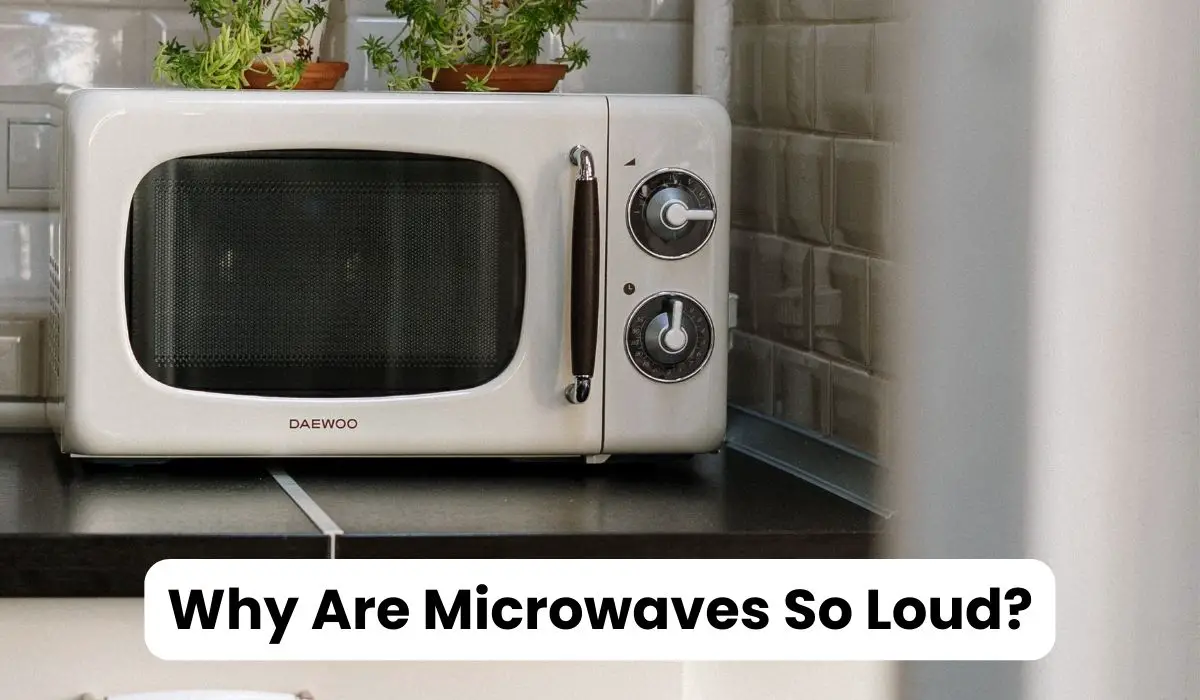The microwave is an indispensable ally for quick and convenient cooking in kitchen appliances. However, the intrusive noise emitted by microwaves has long been a topic of curiosity for users seeking a quieter culinary experience.
In this comprehensive guide, we delve into the heart of the matter, exploring the reasons behind the clamour and providing practical solutions to transform your cooking oasis into a serene space.
So, Let’s start.
Table of Contents
Why Are Microwaves So Loud?
Microwaves, the unsung heroes of the modern kitchen, have revolutionized how we approach cooking and food preparation. With their lightning-fast cooking times and unparalleled convenience, these compact culinary workhorses have earned a permanent place on countertops worldwide. However, amid the efficiency and speed, a question often lingers in the background: Why are microwaves so loud? The answer to this auditory mystery lies in the intricate dance of science and engineering within the confines of this seemingly straightforward appliance.
The microwave’s magnetron is at the heart of the matter, a key component responsible for generating the electromagnetic waves that cook our food. In action, the magnetron engages in a frantic dance of converting electrical energy into microwave radiation. This process, while efficient, is more than a silent affair. The vibrations and movements within the magnetron set off a chain reaction of audible vibrations, resulting in the hum, buzz, or even occasional clatter that we associate with microwaving.
Moreover, the interaction between the microwaves and the food contributes to the overall noise level. As the microwaves penetrate the food, they cause the water molecules within to vibrate, generating heat. These molecular gymnastics produce a subtle hum. Depending on the composition of the food, this hum can vary, adding to the auditory tapestry of the microwave experience.
The turntable, a feature designed to ensure uniform heating, also plays a role in the audible drama. As it rotates, the turntable introduces additional mechanical movements, creating a rhythmic sound that syncs with the microwave’s overall cadence. The clinking or whirring sound you hear is the turntable doing its choreographic routine to ensure your meal is evenly heated.
The microwave’s casing and construction further contribute to the noise factor. Modern microwaves are equipped with insulation to contain electromagnetic radiation and prevent leaks. However, this insulation can inadvertently amplify internal noises, making them more perceptible to us. The materials used in the microwave’s construction, such as metal and plastic, can also affect how sounds resonate within the appliance, contributing to the audible medley.
While the microwave’s clamour may seem unavoidable, some practical steps exist to mitigate the noise. First and foremost, proper maintenance goes a long way. Regular cleaning and inspecting of the turntable and the microwave interior can prevent any loose components from creating unnecessary rackets. Ensure that the turntable is seated correctly and that no foreign objects are causing disruptions.
Consider placing a microwave silencer or noise-absorbing material inside the appliance if the noise persists. These solutions can help dampen vibrations and reduce the overall sound output. However, it’s crucial to use materials that are safe for microwave use and won’t interfere with the appliance’s functionality.
In short, the symphony of sounds emitted by microwaves results from the intricate processes within this kitchen. The magnetron’s energetic ballet, the molecular jigs of water molecules, and the turntable’s choreography all contribute to the audible experience. Understanding why microwaves are loud enables us to appreciate the complexity of their operation. So, the next time your microwave hums its culinary tune, you’ll know it’s simply performing its gastronomic symphony, making mealtime a bit more melodic.
How Does a Microwave Oven Work?

Operating on an almost magical principle, a microwave oven is a staple in kitchens worldwide, transforming how we prepare and reheat our meals. The remarkable ability to generate and utilize electromagnetic waves is at the core of its functionality. These waves, commonly known as microwaves, are harnessed to swiftly and efficiently cook food. The key player in this culinary spectacle is the magnetron, a small yet powerful component within the microwave.
When you set the cooking time and power level on your microwave, you initiate a sequence of events orchestrated by the magnetron. This device converts electrical energy into microwave radiation, at the heart of the microwave’s cooking prowess. As electricity courses through the magnetron, it encounters a magnetic field, prompting the release of microwaves.
These microwaves, which have a frequency of around 2.4 gigahertz, are specifically tuned to interact with water molecules in food. Water molecules, possessing a positive and negative end, respond to the alternating electromagnetic fields of the microwaves. This interaction causes the water molecules to vibrate incredibly, generating heat.
The rapid vibration of water molecules throughout the food leads to a uniform and swift heating effect. Unlike conventional ovens, which rely on external heat sources gradually penetrating the food, a microwave oven heats the food from the inside out. This unique approach accounts for the remarkable speed at which microwaves can cook or reheat various dishes.
The turntable within the microwave plays a crucial role in ensuring even heating. By rotating the food throughout the cooking process, the turntable distributes the microwaves more uniformly, preventing hotspots and ensuring that every part of the dish receives the same heat level. This rotation is not only practical but also contributes to the overall efficiency of the microwave.
In addition to the cooking process, the microwaves can also interact with the materials of the container holding the food. Microwave-safe containers are designed to allow the microwaves to pass through without causing any damage. However, materials that are not microwave-safe can lead to fires or damage to the appliance.
The ability to precisely control the cooking time and power level adds another layer of convenience to microwave ovens. This feature allows users to tailor the cooking process to different types of food, ensuring optimal results for everything from leftovers to popcorn.
While the workings of a microwave oven may seem complex, the fundamental principle is elegantly simple – leveraging the power of microwaves to excite water molecules and generate heat. This innovative approach to cooking has become an integral part of modern kitchen life, offering speed, efficiency, and versatility in the culinary realm. The next time you place a dish in the microwave, know that behind the hum and glow lies a sophisticated dance of electromagnetic waves, transforming your raw ingredients into a delicious, piping-hot meal.
How Can I Prevent My Microwave From Making Noise?

Consider implementing a few practical measures to bring tranquillity to your kitchen and quell the symphony of sounds that accompany your microwave. Begin by ensuring that your microwave is placed on a level surface. Uneven placement can lead to vibrations and increased noise during operation. Additionally, ensure the turntable, a key player in the microwave’s audible performance, is properly seated and debris-free. Irregularities in the turntable’s rotation can introduce unnecessary clatter, disrupting the overall harmony.
Regular maintenance is paramount in the quest for a quieter microwave. Keep the interior and turntable clean, removing any food splatters or residue that may contribute to noise. Loose components within the microwave can amplify sounds, so thoroughly inspecting the appliance’s interior can help identify and eliminate potential culprits. Taking the time to tighten any loose screws or bolts can make a significant difference in reducing vibrational noise.
Consider investing in a microwave silencer for those seeking a more advanced solution. These noise-absorbing devices are designed to be placed inside the microwave, dampening vibrations and lowering the overall sound output. When selecting a microwave silencer, ensure that it is made from materials safe for microwave use and that it does not impede the appliance’s functionality.
Experimenting with the placement of the microwave within your kitchen can also impact its noise levels. If possible, avoid positioning the appliance against walls or cabinets that may act as amplifiers for sound. Opting for a location that allows for ventilation and minimizes the reflection of noise can contribute to a quieter microwave experience.
Furthermore, be mindful of the types of containers used for microwaving. Opt for microwave-safe dishes that fit securely on the turntable, reducing the likelihood of vibrations and rattling. The dish’s composition can also influence noise levels, with glass and ceramic containers generally producing less sound than their plastic counterparts.
Consider adjusting your microwaving habits to minimize noise. Opt for lower power levels when appropriate instead of relying on high-power settings that amplify vibrations. Similarly, using the microwave’s timer to avoid prolonged cooking can create a quieter experience.
How Loud Should A Microwave Be?

Determining the acceptable noise level for a microwave involves a delicate balance between functionality and the comfort of your kitchen environment. Ideally, a microwave should operate at a volume that complements its efficiency without becoming intrusive in your culinary space. In kitchen appliances, a reasonable guideline is to aim for a microwave noise level below 70 decibels. This benchmark allows for effective operation without creating a disruptive auditory experience.
To put it in perspective, a microwave operating at 70 decibels is comparable to the background noise in a busy restaurant or the hum of a conversation. This level strikes a balance, allowing the microwave to perform its culinary duties without dominating the acoustic landscape of your kitchen.
However, it’s crucial to note that noise perception is subjective, and what may be acceptable to one person might be considered loud by another. Factors such as the location of the microwave within your kitchen, the insulation of the appliance, and the presence of additional noise-absorbing materials can all influence your tolerance for microwave sounds.
Moreover, the type of noise matters. A consistent, low-level hum may be less bothersome than irregular clatters or sharp noises. Understanding the sources of microwave noise, such as the magnetron, turntable, and construction materials, can aid in identifying ways to mitigate sound disturbances.
If your microwave exceeds the acceptable noise threshold or has become louder over time, it may be worth exploring maintenance and troubleshooting options. Loose components, worn-out turntable mechanisms, or debris within the appliance can contribute to increased noise levels. Regular cleaning, inspection, and addressing any mechanical issues can help restore your microwave to a quieter state.
Conclusion:
At the end of this article, we’ve uncovered the mystery behind the cacophony that fills our kitchens every time we hit the ‘start’ button on our trusty microwaves. From the whirring of the turntable to the hum of the magnetron, these seemingly noisy kitchen companions are, in fact, quite the symphony of technological marvels.
As you navigate the science of microwaves and sound, remember that behind the racket lies a world of fascinating physics and engineering.
So the next time your microwave serenades you with its unique melody, you can appreciate the choreography of technology that turns your leftovers into a piping-hot masterpiece. Happy microwaving, and may your kitchen be filled with delicious aromas and the sweet sound of culinary efficiency.
FAQs
Can I fix the noise issue in my current microwave?
Yes, many noise issues can be addressed through simple maintenance or DIY fixes. Check our article for practical solutions.
Why does my microwave make a buzzing noise?
Your microwave may produce a buzzing noise due to various factors, including the magnetron’s operation, loose components, or aging parts.
Can I fix a loud microwave myself?
While some issues, like loose components, can be fixed at home, consulting a professional for more complex problems is advisable to ensure safety and efficiency.
Can a noisy microwave be harmful?
In general, microwave noise is not harmful. However, prolonged exposure to loud sounds can be a nuisance and impact overall kitchen comfort.



